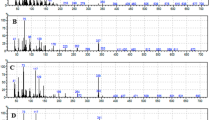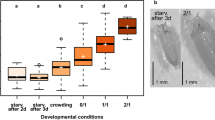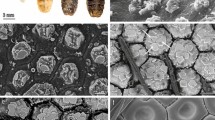Abstract
THE fat body in an insect commonly contains a single cell type which is functionally diverse. At various times it stores and mobilizes fat, protein and glycogen which it may have synthesized or sequestered. In general the fat body becomes filled with reserves as metamorphosis approaches1. Larvae of Aëdes fed on casein build up reserves of protein granules in the fat body2, and in Drosophila larvae, protein granules are induced to form in the middle of the third stadium by a hormone from the ring gland3. In Calpodes larvae the protein granules are probably translocated endocuticle. They arise suddenly within the Golgi vesicles 30–35 h before pupation, at a time when the thick larval endocuticle is being resorbed by the moulting fluid. At about 10 h before pupation other granules containing both protein and ribosomes arise from the isolation of endoplasmic reticulum in cytolysomes4. Although the formation and occurrence of protein granules in the fat body are well documented, there is little information on the origin of the protein.
This is a preview of subscription content, access via your institution
Access options
Subscribe to this journal
Receive 51 print issues and online access
$199.00 per year
only $3.90 per issue
Buy this article
- Purchase on Springer Link
- Instant access to full article PDF
Prices may be subject to local taxes which are calculated during checkout
Similar content being viewed by others
References
Wigglesworth, V. B., Principles of Insect Physiology (Methuen and Co., Ltd., London, 1953).
Wigglesworth, V. B., J. Exp. Biol., 19, 56 (1942).
Butterworth, F. M., Bodenstein, D., and King, R. C., J. Exp. Zool., 158, 141 (1965).
Locke, M., and Collins, J. V., J. Cell Biol., 26, 857 (1965).
Shigematsu, H., Nature, 182, 880 (1958).
Roodyn, D. B., Reis, P. J., and Work, T. S., in Protein Biosynthesis, edit. by Harris, R. J. C. (Academic Press, New York, 1961).
Gaudecker, B., Z. Zellforsch., 61, 56 (1963).
Passoneau, J. V., and Williams, C. M., J. Exp. Biol., 30, 545 (1953).
Straus, W., J. Histochem. Cytochem., 12, 463 and 470 (1964).
Author information
Authors and Affiliations
Rights and permissions
About this article
Cite this article
LOCKE, M., COLLINS, J. Sequestration of Protein by the Fat Body of an Insect. Nature 210, 552–553 (1966). https://doi.org/10.1038/210552a0
Issue Date:
DOI: https://doi.org/10.1038/210552a0
This article is cited by
-
Ultrastructural changes in the fat body of desert locust, Schistocerca gregaria (Orthoptera: Acrididae) treated with zinc chromium oxide nanostructures via chemical co-precipitation approach
BMC Chemistry (2023)
-
The effects of a human food additive, titanium dioxide nanoparticles E171, on Drosophila melanogaster - a 20 generation dietary exposure experiment
Scientific Reports (2018)
-
Significance of the variation in haemolymph copper-protein ratio in the crabScylla serrata (Forskal) during different hours of the day
Experientia (1980)
-
Peroxidase uptake by the fat body of a millipedeSpirostreptus asthenes (diplopoda, myriapoda)
Experientia (1971)
Comments
By submitting a comment you agree to abide by our Terms and Community Guidelines. If you find something abusive or that does not comply with our terms or guidelines please flag it as inappropriate.



